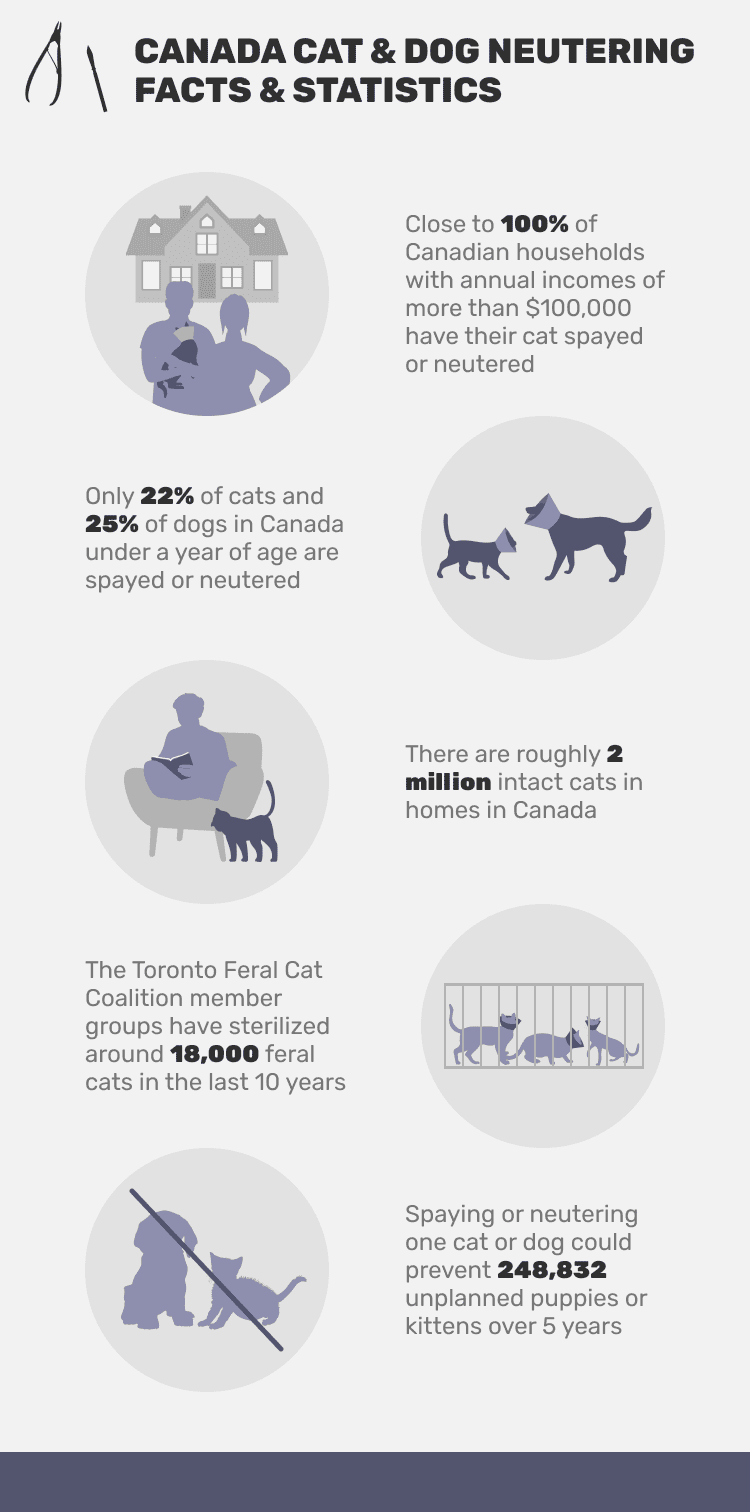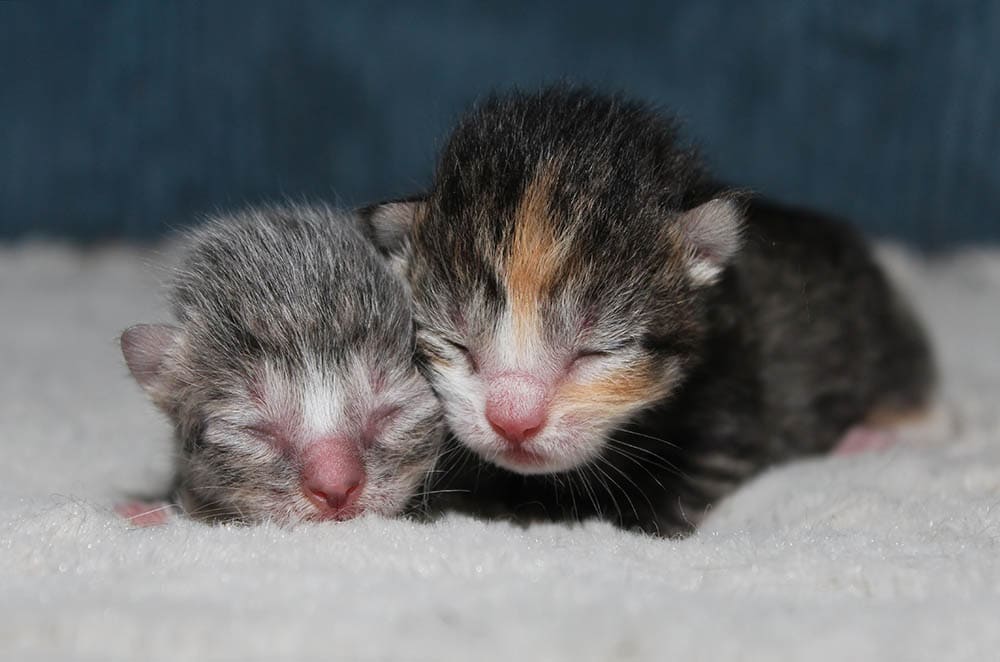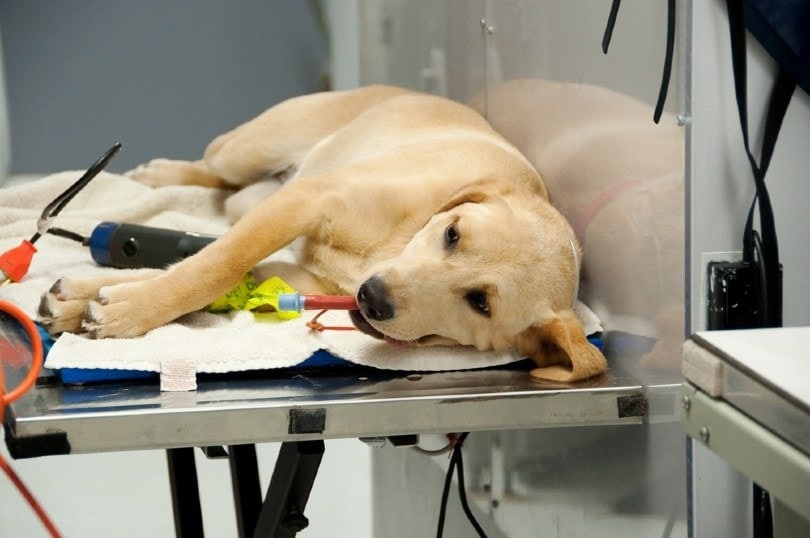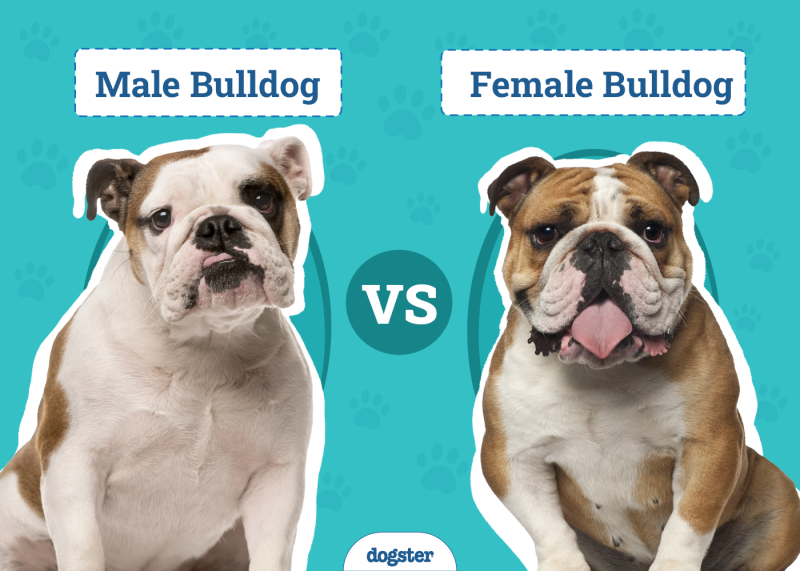In this article
Note: This article’s statistics come from third-party sources and do not represent the opinions of this website.
Neutering is considered a part of responsible dog and cat ownership. Not only will neutering prevent unwanted kittens and puppies from living on the streets, but it can also reduce your pet’s likelihood of developing certain health conditions.
In Canada, neutering and spaying are much more commonplace now than they were once, but there is room for improvement. Keep reading to find ten surprising statistics about pet sterilization in Canada.

Top 10 Canadian Cat & Dog Neutering Statistics
- Over 90% of cat owners self-report spaying or neutering their cats.
- Close to 100% of households with annual incomes of more than $100,000 have their cat spayed or neutered.
- Only 22% of cats and 25% of dogs under a year of age are spayed or neutered.
- There are 2,000,000 intact cats in homes in Canada.
- Around 15% of Canada’s 8.5 million cats could produce unwanted kittens within the next 12 months.
- Approximately 80,000 cats and dogs are euthanized in Canadian animal shelters.
- The Toronto Feral Cat Coalition member groups have sterilized 18,000 feral cats in the last ten years.
- A mobile spay and neuter clinic in Toronto has spayed or neutered 4,200 animals.
- Spaying or neutering one cat or dog could prevent 248,832 unplanned puppies or kittens over five years.
- The Northern Dogs Project has helped 5,500 dogs be spayed or neutered in remote First Nations communities since 2001.


Cat & Dog Neutering Statistics
1. Over 90% of cat owners self-report spaying or neutering their cats.
(Humane Canada)
Humane Canada surveyed Canadian cat owners, inquiring about the number of cats they owned, how they were obtained, and their spay or neuter status. Ninety-four percent of the owners surveyed reported that their cat was spayed or neutered. This statistic is much higher than Humane Canada’s survey five years earlier, which led researchers to believe that some owners may have been lying about their cat’s spay and neuter status. However, they believe this could be due to people feeling compelled to provide a socially acceptable answer knowing that sterilizing their pet is the right thing to do even if they haven’t done it themselves.

2. Close to 100% of households with annual incomes of more than $100,000 have their cat spayed or neutered.
(Humane Canada)
There may be socio-economic factors to bear in mind when considering the state of cat spaying and neutering in Canada. For example, the average income of surveyed cat owners was $66,000 in the study where 94% of respondents self-reported spaying their cats. But, when looking at the statistics from the same study for households with an annual income of more than $100,000, the rate climbs to 99%. This suggests that lower-income families may not have the financial means to afford veterinary services.
3. Only 22% of cats and 25% of dogs under a year of age are spayed or neutered.
(Terri Perrin)
Cats in Canada receive far less veterinary care than their canine counterparts. The study reveals that 50% of cats have visited a veterinarian in the last 12 months. Only 22% of Canadian cats were spayed or neutered by the first birthday, but 76% will have been altered between the ages of one to three.
Dogs in Canada see veterinarians far more often than cats. This study reveals that 22% of dogs have been to see their vet in the last year, which may stem from the fact that 66% of cat owners received their pet free of charge. Interestingly, only one-quarter of dogs under a year old are spayed or neutered, though 67% will be spayed or neutered between the ages of one to three.

4. There are 2,000,000 intact cats in homes in Canada.
(Humane Canada)
This study suggests there are approximately 10 million owned cats in Canada. Two million of these owned cats are intact. One unsterilized female cat can produce up to 25 kittens in one year. Therefore, if half of the two million owned and intact cats are female, they could add up to 25 million kittens to the feline pool in just one year.

The Repercussions of Intact Cats & Dogs
5. Around 15% of Canada’s 8.5 million cats could produce unwanted kittens within the next 12 months.
(Terri Perrin)
A study revealed that there are 8.5 million cats in 36% of Canadian households. Of these 8.5 million, half do not receive the annual veterinary care they require. In addition, this study revealed that 21% of cat owners have intact cats, and more than half of these had no plans to alter their pet within the next year, meaning that around 15% of Canada’s 8.5 million cats could produce litters of unwanted kittens over the next 12 months.
Assuming half of the unaltered cats are females, they could produce at least two litters of five kittens each in one year, effectively adding over six million more cats to an already overcrowded pool of felines.

6. Approximately 80,000 cats and dogs are euthanized in Canadian animal shelters.
(Etobicoke Humane Society)
Every year in Canada, 80,000 dogs and cats are euthanized in shelters around the country. This is almost half of all animals that are admitted to the shelters. Cats are euthanized at a much higher rate, nearly three times that of dogs. The only thing that can stop the overpopulation of pets and excessive number of unwanted animals is to have your pets spayed or neutered.

Strides Taken to Address Intact Cats & Dogs
7. The Toronto Feral Cat Coalition member groups have sterilized 18,000 feral cats in the last ten years.
(Animal Alliance of Canada)
Several organizations in Toronto are banding together to provide low-cost or free spay and neuter services to residents caring for the stray cat colonies in the city. The feral cat population in Toronto was once estimated to be as high as 100,000. In the past ten years, these groups have sterilized 18,000 stray cats. In addition, low-cost spay and neutering services have been provided to thousands of cats, leading to incredible changes in the Toronto feral cat population.

8. A mobile spay and neuter clinic in Toronto has spayed or neutered 4,200 animals.
(The Toronto Observer)
The Snyptruck, Canada’s first mobile spay and neuter clinic, launched in 2016 in Toronto. This custom-built truck has an integrated operating table and cages for up to 70 animals. It drives through Toronto’s neighborhoods where residents have particular socio-economic needs with the goal of providing spaying and neutering services for the resident’s pets at a reduced cost. This mobile clinic has performed such services on 4,200 animals since its start.
9. Spaying or neutering one cat or dog in Edmonton could prevent 248,832 unplanned puppies or kittens over five years.
(Edmonton Humane Society)
Female cats can give birth to three litters a year, while female dogs can have two or three litters of puppies every year. Cat litters can range from five to 12 kittens, while dog litters can result in five to 15 puppies. Edmonton’s Humane Society has a PALS (Prevent Another Litter Subsidy) Program in effect to help address the city’s homeless pet population. Low-income residents of Edmonton and its surrounding communities can apply through the program to have their cats or dogs spayed or neutered while only paying the administration fee. Over five years, the PALS program can potentially prevent 248,832 unplanned puppies or kittens in the Edmonton area.

10. The Northern Dogs Project has helped 5,500 dogs be spayed or neutered in remote First Nations communities since 2001.
(International Fund for Animal Welfare)
The International Fund for Animal Welfare (IFAW) has been working with First Nations communities in Canada since 2001. The IFAW’s Northern Dogs Project uses tools and approaches to provide resources and support to dog owners in these communities. Since the project’s inception in 2001, it has helped spay and neuter over 5,500 dogs, resulting in fewer unwanted puppies being born.

Frequently Asked Questions About Cat & Dog Neutering
Is it illegal to leave your cat or dog unaltered in Canada?
There are several places in Canada where it is mandatory to spay or neuter your pet. For example, since January 1, 2020, all dogs, cats, and rabbits older than six months must be sterilized in Montreal, Quebec. The same law came into effect in Laval, Quebec in 2018.
In 2005, Ontario passed a law banning its residents from owning Pit Bulls. However, the legislation allowed Pit Bulls already present in the province to stay so long as they were sterilized and always leashed and muzzled in public.
Are there benefits to spaying and neutering cats and dogs?
Aside from preventing unwanted kittens and puppies, there are other reasons all dog and cat owners should consider spaying and neutering their pets.
Medically, spaying a female cat can prevent infections and tumors in its reproductive tract. It can also reduce their risk of developing breast cancer. In addition, neutering male pets can lessen their risk of developing enlarged prostate glands and testicular cancer. (American Veterinary Medical Association)
These procedures can also present behavioral benefits, reducing unwanted behaviors. For example, neutered dogs will be less likely to roam away from their homes and may not mark their territory with urine as often. (Ross University)
Studies suggest that sterilization also positively affects lifespan in both male and female dogs, increasing their lives by 13.8% and 26.3%, respectively (Hoffman et al.) Another study reveals that spayed cats live 39% longer than unspayed cats, and neutered males live 62% longer than their unneutered counterparts. (Banfield Pet Hospital)
Are there any cons of spaying or neutering your pet?
Sterilization procedures are common, but there’s always some degree of risk for animals undergoing surgery and with anesthesia. Your vet should thoroughly examine your pet before the surgery to ensure it is in good health. They may recommend blood work to ensure your pet has no underlying health issues that could affect their recovery from surgery.
Dogs tend to require fewer calories post-operation to prevent excess weight gain. You should reduce their caloric intake by 20% (PetMD) but always check with your vet to see what they recommend.
What does it cost to get your pet spayed or neutered in Canada?
The cost of these procedures will vary from vet to vet and region to region. Your pet’s size and age may also affect the price. Generally speaking, you can expect to pay between $100 and $400 to have your pet spayed or neutered. The spaying procedure for female pets is typically more expensive as it is more complex and longer than neutering.
There are low-cost or free clinics all over Canada for pet owners that cannot afford these procedures. We recommend reaching out to your region’s SPCA to find your options.
When is the best time to get your pet sterilized?
Female and male dogs can safely undergo a sterilization procedure as young as six to eight weeks. (PetMD)
Female kittens can begin their first heat cycle as young as four months, but it typically doesn’t happen for another month or two after that. Therefore, spaying female kittens before they’re five months old is best to prevent unexpected pregnancies. (Human Society)
Male cats are typically neutered when they’re a bit older, between three to six months of age. (Cornell Feline Health Center)
For more information on spaying or neutering your dog, you should contact your vet.

Final Thoughts:
Far too many unwanted cats and dogs are on the streets and filling up shelters in Canada, so spaying or neutering your animals is essential to responsible pet ownership. Of course, there are small risks involved with any surgical procedure, but sterilizations are very common, and the risk is low. If you have any concerns, your veterinarian will be the best person to talk to, as they’ll know your pet’s health history and can provide some valuable insight into whether sterilization is right for your pet.
Featured Image Credit: ARVD73, Shutterstock



















